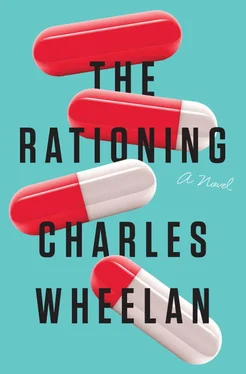“I’m afraid I can’t,” the President said. Several hours later Cecelia Dodds was moved to intensive care.
There was no calm at the NIH offices. The scientists were unhappy that the President had been so sanguine in his remarks about the number of deaths if the Dormigen stocks were depleted. Not only had he focused on the lower bound of what the NIH model was predicting in terms of fatalities, but the model itself had now been revised in the other direction. Evidence of the widespread Dormigen pilferage had filtered back to the data analysts; they were putting numbers against the quantity of Dormigen that had gone missing, which included the tricky task of trying to figure out where the stolen Dormigen would ultimately end up (wasted or helping people who needed it). The best-case scenario for incremental fatalities no longer included “zero.” It had climbed to forty-five thousand. Meanwhile, the added uncertainty had broadened the range of possible outcomes, so the worst-case scenario was now a hundred and ninety-five thousand deaths. The NIH staff had watched the Chinese Ambassador’s remarks; they were feeling the weight of the President’s dilemma.
I apologized to the NIH Director for being late. “Don’t worry about it. I think you’re going to be impressed,” she said, ushering me into a small conference room, where five binders of different colors were laid out neatly on the table. “This can be your workspace.” She pointed at the colored binders. “Those are summaries of the work done so far by each of the working groups: Capellaviridae ; the North American dust mite; possible antidotes; alternative treatments to Dormigen. The organic chemists put together the red one, but they’ve just started.” The work product was impressive. Once again I found myself wondering if we had made an egregious error in keeping the Outbreak secret. If the great minds here had spent less time eating cupcakes in those early days, might we now be a week ahead? “I’ll let you peruse those,” the NIH Director said. “Each one has a summary, so you don’t have to wade into the details. We have a meeting of all the teams in the big conference room in about forty-five minutes. We’re trying to meet every six hours, around the clock.”
The Director left me to the colored binders. I sat down and picked up the one closest to me: green. The summary described the recommended protocol for treating Capellaviridae in the absence of Dormigen: fluids, rest, conventional antibiotics to deal with any secondary infection. I had little to add in this realm, so I set the binder aside. I picked up the blue binder next: Capellaviridae . The report documented everything the team had learned about the virus, which was an impressive amount in such a short time. The summary included three lines in bold text that caught my eye: Capellaviridae bears a striking resemblance to strains of the influenza virus. Some of our scientists, unaware of what they were looking at, assumed they were examining a historic strain of influenza. Not surprisingly, Capellaviridae acts on the body in nearly identical fashion to the more virulent strains of influenza.This explained what I had just read in the green binder, namely that without Dormigen Capellaviridae should be treated like a bad case of the flu. It also explained the likely fatality rate (broadly comparable to a serious flu). Creating a vaccine specific to Capellaviridae would be a straightforward task, but like Dormigen, a flu-type vaccine takes time to cultivate. Time was the one thing we did not have.
Okay , I thought, Capellaviridae is really just a nasty form of the flu that is somehow, and for some reason, passed to humans by the bite of a dust mite . I picked up the yellow binder: everything we now knew about Dermatophagoides mensfarinae , the North American dust mite. There was even a highly magnified photo of the nasty-looking critter on the cover page. Again, I perused the summary. The North American dust mite is different from other common dust mites primarily in that it bites humans. Other mites feed off human detritus, such as dead skin that has been sloughed off. The North American dust mite feeds off live skin and blood, making a tiny, painless bite that causes a modest allergic reaction in some people. The Dermatophagoides mensfarinae research group was operating on the assumption that there is some evolutionary advantage to being able to feed on live skin and blood. They estimated that this mutation in the species had taken place eight thousand to ten thousand years earlier, coinciding with the first modestly dense human settlements in North America.
That made sense. When humans started living in closer proximity to one another, this particular dust mite developed an ability to feed directly off skin and blood, rather than waiting around for discarded dead cells. I was about to pick up the black binder when the door to the conference room opened and a young woman about my age looked into the room. She was petite, with straight brown hair that hung to her shoulders. “Sorry,” she said sheepishly. I looked up, waiting for some explanation. She said nothing but continued to linger in the doorway, as if deciding what to do next.
“Can I help you?” I asked, genuinely perplexed.
“Someone told me you had Professor Huke,” she said. “I’m really sorry to bother you, with all that’s going on.”
“How do you know Professor Huke?” I asked. And then: “Please come in.”
She came into the conference room and stood on the other side of the table. I motioned to a seat, but she remained standing. “I took his class at Dartmouth,” she said. “Two of his classes, actually.”
“And what are you doing now?” I asked.
“I just finished a graduate program in public health. I’m doing a fellowship at the CDC. They sent me over here when the crisis broke—an all-hands-on-deck kind of thing.”
“I went to see him—Huke,” I said. “I went back to Hanover to ask him about this.”
“What did he say?”
“It was before everything was public, so he thought I was just working on some academic puzzle. He told me to pretend it was a question on a midterm exam.”
“Seems like it should at least be the final exam,” she said.
I laughed. “Yes, that’s true. He said the usual things: think like a virus, figure out the evolutionary advantage, that kind of stuff.”
“And?”
“And it doesn’t make any sense. We have a relatively benign virus that kills its host to no obvious advantage.”
“I really didn’t mean to bother you,” she said, turning to go. “It just seemed too crazy: two Huke grads in the middle of this virus crisis. I’ll let you get back to what you were doing.”
“If you really want to help,” I said, causing her to pause in the doorway, “work through this with me.” I pointed at the binders. “It’s not crazy to think of this like a Huke final exam. I feel like everything I need to know is right there. I just can’t make sense of it. My brain’s in a fog.”
“When was the last time you slept?” she asked, looking at me in a way that reminded me of the toll the morning had taken. My suit was still wrinkled from the rain. I had the remnants of television makeup on my neck and collar.
“A couple hours last night,” I offered.
“You know what the research says.”
“The research on what?”
“On how the brain works,” she said. “You can stare at that table all afternoon. You’d be better off taking a walk and not thinking about it for a while.”
“Now’s not really a great time for a walk,” I said with a hint of impatience.
She came right back at me. “Well, do you want people to think you’re working hard in this little room, or do you want to figure out the puzzle?”
Читать дальше












